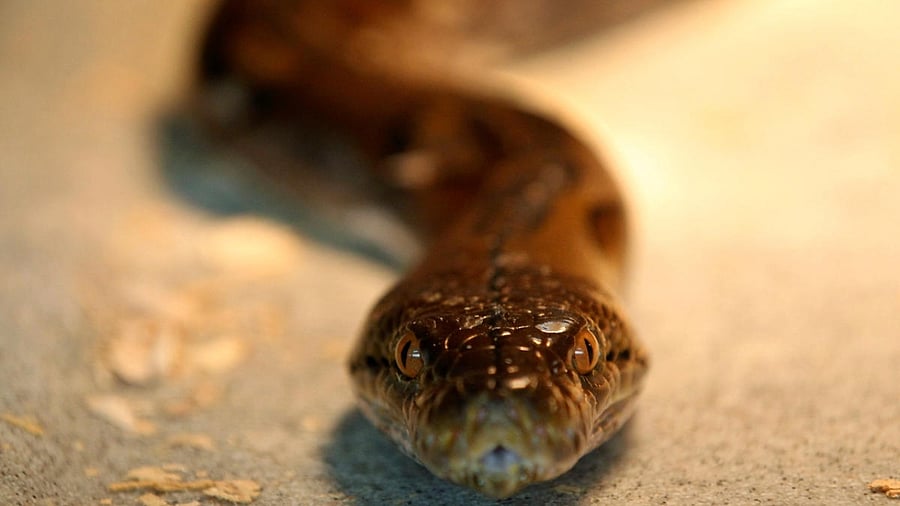
While the monsoon is a lifeline to India’s agriculture-dominated economy, the deluge brings out slithering killers—snakes. Snake bites peak during the monsoon months—a period when increased human activities on agricultural fields coincide with snakes hatching their young ones.
Inherently shy, snakes can turn defensive when disturbed or threatened. The slithering reptiles then bite by injecting a cocktail of toxins at the intruder through their fangs. Based on the species of snake, the toxins can over time cause respiratory paralysis, bleeding, breakdown of muscle fibres, shocks, organ failures, and death. It only takes a few hours to sniff out human life with a snake bite.
Studies estimate that each year, about five million snake bites occur around the world, while 81,000 to 138,000 people die and about 400,000 people are left with permanent disabilities and amputations. India has the highest burden of such deaths. In 2019, snake bites reportedly killed 54,600 people and maimed nearly 2.5 million in the country, and a whopping 86 per cent of global deaths and disabilities due to snake bites were from South Asia. Chhattisgarh, Uttar Pradesh and Rajasthan recorded the most deaths.
India is home to over 300 species of snakes, of which nearly 60 are known to be venomous. But, about 9 in 10 deaths are caused by the ‘Big Four’— the spectacled cobra (Naja naja), common krait (Bungarus caeruleus), saw-scaled viper (Echis carinatus) and Russell’s viper (Daboia russelii).
For more than a century, India’s reputation as a country with significant preventable snake bite-related deaths has been scientifically established. In the late 1800s, British physician Joseph Fayrer, who served as the Surgeon General in India, published a study titled ‘Destruction of Life in India by Poisonous Snakes’ in the journal Nature, where he presented statistical information on the astounding toll of snake bites on human and animal life and investigated how different poisons from different snakes behaved and what could be done to prevent such deaths.
Yet, India continues to carry the world’s highest burden of snake bite-related deaths and disabilities. Romulus Whitaker, a herpetologist and conservationist, says that there is a drastic under-reporting of India’s snakebite crisis. The World Health Organisation has categorised ‘snakebite envenoming’, a medical term for snakebite, as a Neglected Tropical Disease (NTD) globally. “It’s a poor man’s problem and that’s why it doesn’t receive a lot of attention,” says Kartik Sunagar, who heads the venomics lab at Indian Institute of Science, Bengaluru.
“Snakebite is a complex problem with many social, occupational, environmental and economic factors influencing its occurrence,” says Ravikar Ralph, a professor at the Christian Medical College, Vellore.
Healthcare access
While deaths due to snakebites are preventable with the availability of antivenoms, accessing it within six hours, after which the probability of death increases, is not easy. Since most snakebite victims are from rural areas, transporting them to healthcare centres equipped with antivenoms and critical care facilities, like ventilators and blood banks, can take very long. In many areas, emergency transport like ambulances are scarce.
Even when the necessary infrastructure is available, the treatment cost is often unaffordable. “People’s reliance on unscientific traditional cures causes fatal delays in effective treatment,” says Whitaker. “Quack cures and herbal/religious “doctors” must be brought to book, as they are responsible for a staggering percentage of the deaths by snakebite.”
Among medical professionals, the knowledge on treating snakebites is scant. “A lot more is covered in the medical curriculum on dengue, cholera etc than what is for snakebites,” says Ralph, who published a study on how to manage snakebites clinically. “While it’s extremely important that deaths due to infectious diseases be prevented, it is equally important that the prevention of snakebites and related deaths receives the same degree of attention.”
Vexing science of venoms
Biologically, venoms are a mix of several proteins. Each species produces a different cocktail of venoms. But, our understanding of the various snake venoms and subtle differences between the toxins produced by the same species is insufficient.
“We don’t know a lot about the ecology or the biology of these snakes,” says Kartik Sunagar. “There’s not a lot of financial or scientific resources devoted to solving this problem.”
Currently, all antivenoms used to treat bites from the ‘Big Four’ snakes in India are produced using venoms extracted by the Irula Cooperative from just two districts in Tamil Nadu using century-old techniques. But, Sunagar’s studies on the composition of snake venoms in India have shown that these antivenoms are ineffective in other parts of India, including South India, because all venoms are not created equal. A snake venom’s composition depends on the age of a snake, its gender and its biogeography, and based on the ecology and diet, venoms vary dramatically within the same species.
Sunagar’s study also found that one of the marketed antivenoms, designed for treating bites from the ‘Big Four’, failed to sufficiently neutralise the venom of the common krait from North India.
Need for urgent interventions
For a country touted as the world’s pharmacy, manufacturing necessary and efficient antivenoms is not impossible. But today, only a handful of pharmaceutical companies are in the business because, as Sunagar says, “it’s not something that will earn you a lot of bucks.”
While the Union Ministry of Health and Family Welfare has recognised the gravity of the issue, concrete steps towards reducing snakebites are yet to be framed. Sunagar urges the government to fast-track regional antivenom collection and production and chart out a way for scientists and medical practitioners to work together to develop effective treatments against snakebites. Improving healthcare infrastructure and access in rural areas is necessary. Beyond everything, creating awareness about the issue and taking precautions to avoid snakebites must be a priority.